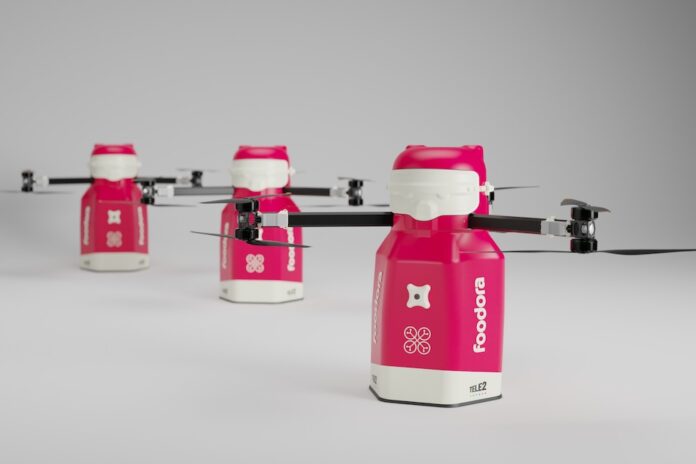Drones are becoming one of those killer 5G apps we were all promised a decade ago
Tele2 has teamed up with foodora and Aerit to launch food deliveries using IoT and 5G connected drones. The deliveries will be made wherever possible to the customers’ property or garden and lowered with a cable from the drone, with the first deliveries taking place already in the spring on Värmdö, outside Stockholm.
The operator has been working with Nokia and AirForestry to use high-capacity, 6m-wide drones for forest thinning from the air. These are controlled by a 5G private wireless network and if the pilot is successful throughout this year, it will be deployed into commercial forestry operations. The drones are controlled from a portable shed with 5G antennas that are positioned to cover the area to be thinned. The mobile solution allows it to be easily set up where needed and where there is no public coverage or any other alternative technologies.
Tele2’s 5G will support foodora Air’s fleet of electric drones that will provide the food delivery service from several restaurants on Värmdö, outside Stockholm. The operator will provide continuous connectivity for the drones based on 5G IoT. Drones require both short response times and the ability to send and receive large amounts of data to handle deliveries safely, supported by 5G.
Aerit has developed advanced drones integrated into foodora’s technology platform to create an efficient delivery experience. Deliveries will commence in May on Värmdö and food can be ordered through the foodora app. The goal is to expand to more areas in Sweden so that more locations can have access to the same service available in major cities.
The delivery flights, conducted beyond visual line of sight (BVLOS), provide on-demand access to goods and services for approved households within Aerit’s 100-square-kilometre coverage area.
This marks a new era in how people receive deliveries, and we believe we can see more applications in other industries,” said Tele2 head of business affairs Stefan Trampus. “The partnership with foodora is a perfect example of how we can use our 5G connectivity and expertise to drive future delivery services in a simple, sustainable, and smart way, while providing customers with an extraordinary experience.”
Greener option than alternatives
The drones have a range of 21km and emit 2 grams of carbon dioxide per kilometre, which can be compared to traditional gasoline or diesel-powered delivery vehicles that emit 143 and 110 grams of carbon dioxide per kilometre, respectively. The maximum delivery range is 12km and the payload is 4kg. Aerit’s Nimbi drones also feature a proprietary winching system that allows for both package pick-up and drop-off without the need for supporting infrastructure.
“Technology and connectivity have the potential to break many of the limitations that currently exist in rural areas, where access to various services and products has decreased in line with rapid urbanisation, added Trampus.
“We are proud to be the first in Europe to launch real drone deliveries, and we are excited to have Tele2 and Aerit as partners on this exciting journey. Fast home deliveries are a democratic issue, in my opinion. Regardless of where you are in the country, it should be possible to quickly get what you need, such as medicines or groceries. It should not only be available to people who have chosen to settle in big cities,” said foodora operations director Daniel Gustafsson Raba.
“We are thrilled to join forces with foodora and Tele2 to accelerate the adoption of drone delivery across Europe. Today’s announcement means our mission, to provide emission slashing access to goods and services by leveraging our cutting-edge drone courier networks, takes a leap into the future,” said Aerit CEO Alexander Perrien. “Drone delivery is here, and this partnership will provide the foundation for Aerit to scale at speed.”



